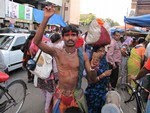Women in Nepal are not enjoying their rights. THe women who are uneducated or illiterate feel that they are not so capable as men. They feel themselves weaker. They depend on male members of the family. They cannot enjoy any rights and freedom. Some of the conscious and educated women enjoy different modes of freedom and rights.
We can realize discrimination between men and women. They enjoy and practise different modes of freedom and rights. All the rights can be classified into social and legal. We can see greater discrimination between men and women in social rights. For example, a mother cannot be the head of the family. She cannot make any decision for her family. She is socially compelled to depend on her husband. Our society views that polygony can be practised but not polyandry. In some particular rituals, women are prohibitited to be involved. Our society does not permit a widow to get married, but a wodower is welcomed to get married.
Legally many rights are provided to women. For example, they are provided with the right to be candidate in the election. They can go anywhere freely to get jobs. They are equally welcomed in all the sectors. They can go any academic institutions to study.
'Women rights in Nepal' cannot be said miserable. The status of Nepalese women is improving. Our society has also reformed the evil traditions and social practices. The social values and norms which are not fair have been changed.
We can realize discrimination between men and women. They enjoy and practise different modes of freedom and rights. All the rights can be classified into social and legal. We can see greater discrimination between men and women in social rights. For example, a mother cannot be the head of the family. She cannot make any decision for her family. She is socially compelled to depend on her husband. Our society views that polygony can be practised but not polyandry. In some particular rituals, women are prohibitited to be involved. Our society does not permit a widow to get married, but a wodower is welcomed to get married.
Legally many rights are provided to women. For example, they are provided with the right to be candidate in the election. They can go anywhere freely to get jobs. They are equally welcomed in all the sectors. They can go any academic institutions to study.
'Women rights in Nepal' cannot be said miserable. The status of Nepalese women is improving. Our society has also reformed the evil traditions and social practices. The social values and norms which are not fair have been changed.






